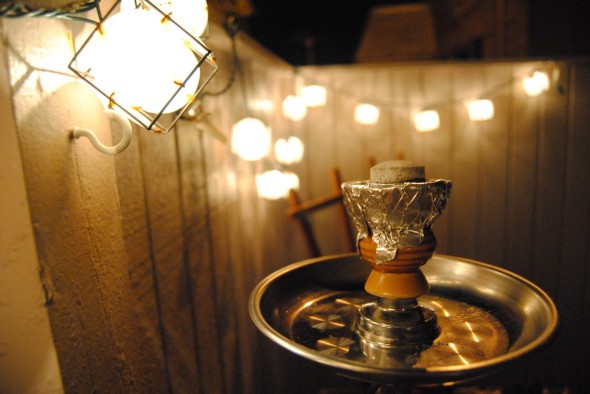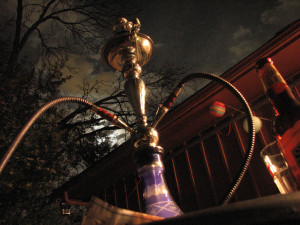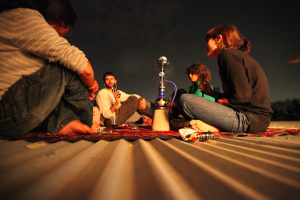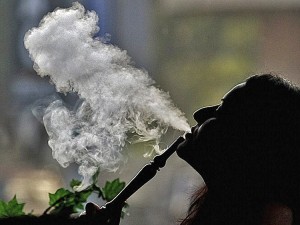A typical one-hour session of smoking shisha involves inhaling 100 to 200 times the volume of smoke inhaled with a single cigarette, according to a study by the World Health Organisation (WHO). Shisha, also known as the Turkish water pipe, narghile, hookah, or hubbly-bubbly, contains tobacco and is classed in the same category as cigarettes. It is subject to the smoking ban, enforced in England in July 2007 and is illegal to smoke it in indoor public places.
Smoking shisha has increased in popularity over the last few years, despite the smoking ban. In the borough of Westminster in London, the number of shisha cafés has risen by 68% since 2007. More cafés have sprung up because business owners are able to get around the ban by having their cafés half uncovered or by providing patio seating or garden terraces.
How does a water pipe work?
Smoking a water pipe involves using a long pipe with a flexible tube connected to a conduit, which is submerged in water. Flavoured tobacco is placed on the head of the water pipe and then heated by putting charcoal on top of it. The other end of the tube is the pipe part, which is placed in the user’s mouth to inhale from.
When the pipe is sucked, the smoke is drawn through the conduit and underwater. The smoke rises up above the water, through the pipe into the user’s mouth. Typically, cigarette smokers take 8 to 12 puffs over about five to seven minutes and inhale about a pint of smoke. Shisha smoking sessions usually last 20 to 80 minutes and smokers may take 50 to 200 puffs, which range from about five ounces to one quart of smoke each, according to the WHO. A shisha smoker may inhale as much smoke in one session as a cigarette smoker would inhale if her or she consumed 100 or more cigarettes.
What is the attraction?
The tobacco smoked in a water pipe is flavoured with fruit molasses so the residual, redolent smoke is sweet and therefore can be misconstrued as being safer than smoking cigarettes. Because the smoke is infused with fruity flavours like strawberry, apple, cherry, grape, and so on, the smoke produced is aromatic, attracting teenagers and young adults who may not usually smoke cigarettes. It is seen as a socially cool and trendy pastime, but more disturbingly, most people consider shisha smoking to be harmless. Shisha can now be found on many university campuses across the UK in bars that serve shisha outdoors, as it is cheaper than a round at the pub. One shisha usually costs between $11 and $24 and is often shared by two or three people. It could last all evening as long as the coal is replaced every time it burns out.
Porsche Design has just launched its own high-end water pipe made from aluminum, stainless steel, and glass and is available only in Harrods in Knightsbridge, further endorsing the image of shisha as being a fashionable thing to do or own. The water pipe has been used to smoke tobacco for centuries, primarily in Northern Africa and Asia. It is often used as a decorative object and is a prominent part of Middle Eastern culture. Smoking shisha is a social activity, similar to how beer and wine is consumed in Europe. The negative effects of shisha have only recently emerged.
Health risks
The WHO guidelines state: “The smoke that emerges from a water pipe contains numerous toxicants knows to cause lung cancer and heart disease.” Professor Robert West, director of Tobacco Studies at University College London, explained in an interview: “Smoke from tobacco contains a number of known carcinogens, which damage the DNA in the cells. The problem arises if the DNA is damaged in such a way that it turns off its capacity to control cell division. Just one damaged cell can divide and multiply uncontrollably and can quite quickly develop into a large tumor. This causes lung cancer.”
There are other risks as well. As the mouthpiece is passed around from person to person, this raises the risk of transmitting diseases such as tuberculosis and hepatitis. Even if you do not smoke shisha and just go along with friends, the risks from passive smoking are just as harmful. Professor West says, “The greater the exposure in terms of duration and amount smoked, the greater the risk to your health. Just being in a smoky environment is damaging.”
Enthusiasts claim that as the smoke passes through water, most of the harmful chemicals are absorbed. However, there is no evidence to support this theory and the risks associated with smoking, including respiratory disease and cancer, remain high. Typically a shisha smoker can spend from 20 minutes to two hours smoking in one session. For some, it can last a whole evening, with the burning coals replaced as the night wears on. Carbon monoxide and carcinogens are just some of the by-products of combusted coal.
Growing concerns
Mark Hendrick, MP for Preston, raised concerns during the Summer Adjournment debate in Parliament held in July 2011, following an Early Day Motion (EDM) he initiated earlier, titled “Health effects of shisha smoking.” The EDM aims to highlight the growing popularity of shisha culture and cafés in Preston and other cities in the U.K.
Mark Hendrick’s website PrestonMP.co.uk reported that the outcome of this debate caused Paul Burstow, the minister of health, to state: “Water pipe use might actually increase exposure to carcinogens by smokers and those exposed to second-hand smoke. The evidence is clear that water pipe usage can increase the risk of cancers of the lung, mouth, and bladder. It is also associated with markers of cardiovascular and respiratory diseases and an increased risk of mouth and gum disease.” He went on to add, “We believe that, as local authorities take on their new public health responsibilities over the next few years in conjunction with Public Health England, they will be well-placed to improve awareness of the risks of these practices.”
It is not just the UK where shisha smoking is becoming more popular. For cultural reasons, it was previously exempt from U.S. smoking laws. Shisha is now being targeted by campaigners across many states. The activists are seeking for the smoking ban to be extended to include shisha.
The New York Times reported that the governor of New York State, Andrew Cuomo, has signed a new law prohibiting the sale of water pipes and other smoking paraphernalia to minors. A new bill has also been introduced in the New York Legislature to prevent any new shisha cafés or hookah bars from opening in New York starting next year.
According to the Pakistan Observer, residents in some Pakistani cities, such as Islamabad and Rawalpindi, are demanding shisha smoking be banned from restaurants and cafés as the practice has become a fashion symbol of young males and females.
Zahra Ahmad, a dental student in London, enjoys the social aspect of smoking shisha: “I don’t drink so this is a great way to hang out with friends and relax. Most students blow a lot of their money on alcohol, cigarettes, and clubbing. I prefer to do shisha.” When asked in an interview if she knew of the health risks, Zahra said, “I know it’s bad for you, but I have to have fun sometimes, and I only do it occasionally.”
Running a shisha café can be a profitable business as the overhead is low. All the equipment needed can be bought locally and if the water pipe, shisha tobacco, and coal is bought from Egypt or Dubai, the profit margin is even greater. As the warm weather continues throughout the summer, most shisha smokers will unknowingly be putting their health at risk. An increase in awareness is certainly needed among shisha smokers across the globe. One idea is that shisha cafés should display prominent notices: “Smoking shisha can kill,” just as you would see on a cigarette packet.
Professor West says, “Shisha smoking is a growing concern because people aren’t aware of the risks like they are with cigarette smoking. If people think it’s safer than cigarettes when it’s not, they need to be informed otherwise.”
This article was previously published in the Epoch Times, UK








